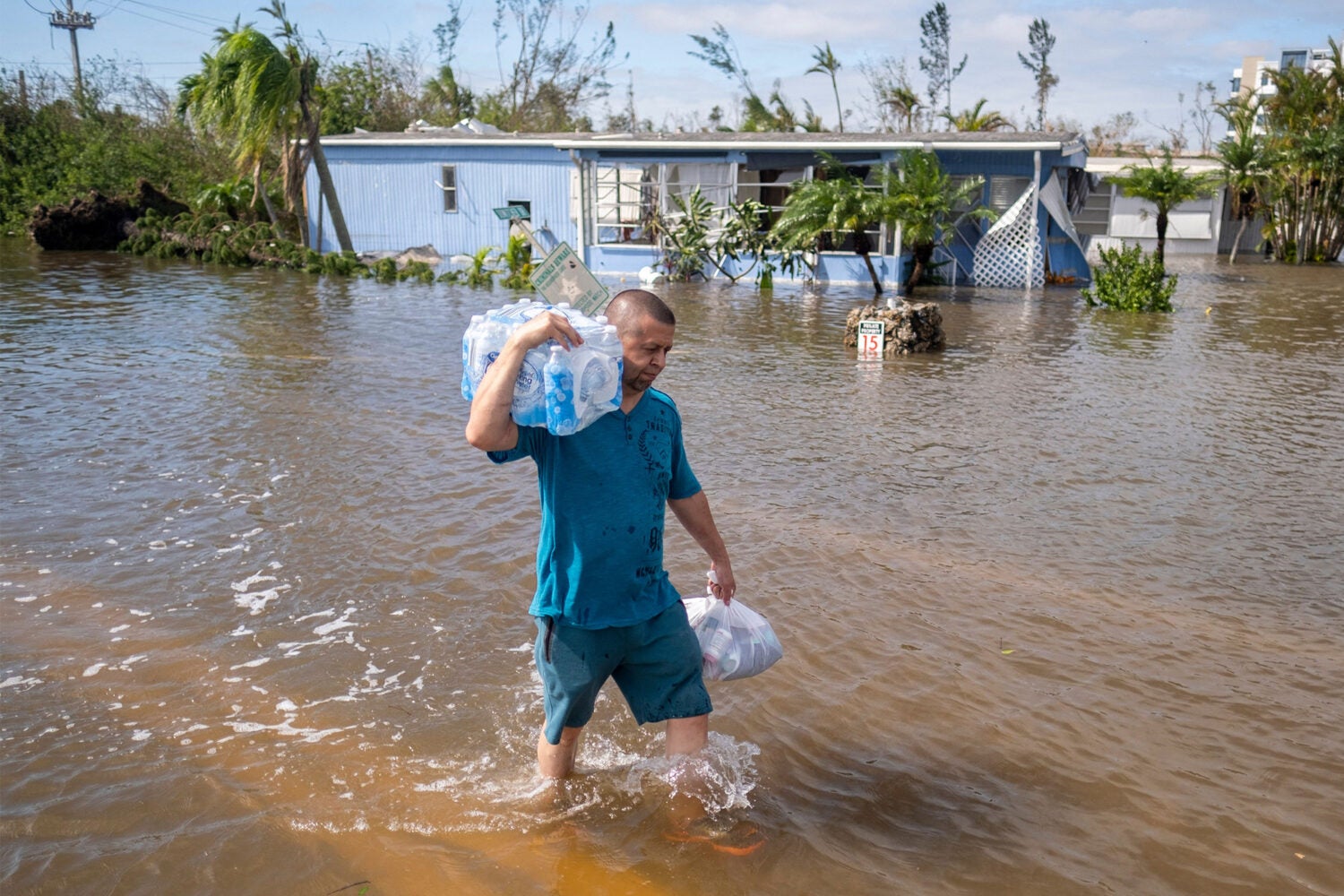When Hurricane Ian devastated communities throughout Florida last month, many affected homeowners lacked the flood insurance they will need to fund repairs their flood-damaged dwellings. To understand why, Harvard Law Today recently reached out via email to Hannah Perls, an expert in equitable disaster preparedness and response. According to Perls, a staff attorney at Harvard Law School’s Environmental & Energy Law Program, the nation’s largest flood insurance program is bedeviled by a host of problems ranging from outdated flood maps to unaffordable insurance. As coastal cities and towns across the U.S. face the prospect of more catastrophic storms in the years ahead, she says the solution is to “invest in community-led, long-term planning processes that assess climate change-related risks in the context of other adaptation goals.”

Harvard Law Today: What role do state and federal governments play in the flood insurance market? And are these insurance plans subsidized by taxpayers?
Hannah Perls: The federal government is the largest provider of flood insurance in the country through the National Flood Insurance Program, or NFIP. Congress created the NFIP in 1968 to provide federally backed flood insurance because most private insurance companies viewed flood risk as uninsurable due to the simultaneous, widespread, and catastrophic damage that often results from these events.
While the frequency and severity of these flood events is increasing due to climate change, the price most policyholders pay under the NFIP does not reflect that risk. This was true even at the program’s inception, when the federal government subsidized or underpriced policies to incentivize participation. Those subsidies, combined with the challenges associated with quantifying and pricing risk to individual properties, leads to FEMA consistently borrowing billions more from the Treasury than it receives in payments from policyholders under the NFIP. So yes, effectively, taxpayers are subsidizing federal flood insurance policies.
To learn more about the history of the NFIP and recent changes FEMA made to its pricing methodology, folks can check out a podcast I recorded with Joel Scata at the Natural Resources Defense Council (NRDC) in February.
HLT: Are you surprised that so many homeowners in Florida don’t have flood insurance? Aren’t they required to be insured?
Perls: I think Hurricane Ian, like many prior disasters, impacted people who thought they were living in a safe area. One reason for this is that FEMA’s flood insurance requirements don’t capture current risk. Flood insurance is required for homeowners who have a federally backed mortgage and live in designated high-risk flood areas. Those areas are based on FEMA’s flood maps, which are often outdated and don’t account for the increased risk of catastrophic events due to climate change. This means homeowners in many inland areas that aren’t exposed to routine flooding aren’t required to carry flood insurance but can still experience severe flooding impacts including storm surge, river overflows, and flash floods. For example, in eastern Kentucky where flash floods hit in August, only 2.3 percent of impacted households had federal flood insurance. Nationwide, there are 5.9 million properties that face significant flood risk, yet they are outside FEMA’s mapped high-risk zones. Studies have also shown that communities of color are much more likely to face flood risk that is not captured by FEMA’s maps, with Latino populations facing 72 percent more unmapped risk than white populations.
Nationwide, there are 5.9 million properties that face significant flood risk, yet they are outside FEMA’s mapped high-risk zones. Studies have also shown that communities of color are much more likely to face flood risk that is not captured by FEMA’s maps.
Another major barrier is affordability. Even if people previously had flood insurance, many households have let their policies lapse in the wake of the pandemic and rapid inflation. For example, Thomas Frank at POLITICO found that of the 1.8 million households in the nine counties covered by President Biden’s disaster declaration for Hurricane Ian, only 29 percent had federal flood insurance. And the county with the lowest coverage rate (1.3 percent in Hardee County) also has the lowest income levels and is 44 percent Hispanic or Latino. On average, flood insurance costs about $1,000 per year (though some households saw their premiums increase in April due to recent changes in FEMA’s pricing policies). Especially in inland areas where the risk of flooding feels more remote, flood insurance becomes a luxury sacrificed to meet other, more urgent needs.
It’s also important to note that FEMA requires disaster survivors in high-risk areas to have flood insurance in order to qualify for other forms of disaster assistance. In theory, this requirement is designed to incentivize people to purchase and maintain flood insurance coverage. In practice, it can punish low-income households that can’t afford to pay their premiums, especially as recent changes to FEMA’s NFIP policy increase premiums for high-risk properties. As a result, low-income households not only lose out on insurance payouts post-disaster, but then are disqualified from receiving federal assistance altogether.
HLT: By providing insurance to homeowners at subsidized rates, are governments creating a moral hazard? In other words, is society inadvertently incentivizing folks to move into high-risk areas?
Perls: This is a really common and intuitive question, but I think the reality on the ground is often much more complicated. The price of flood insurance is one of many variables that determine if, where, and how people move in response to climate-related risk. Other variables include the types of information and resources people have access to. For example, Florida law does not require a seller to disclose a property’s flood risks or past flood damage to a potential buyer. Researchers have also documented patterns of displacement in Florida due to climate gentrification, where lower-income families living further inland are pressured to relocate as those areas become more desirable for redevelopment and investment.
Florida law does not require a seller to disclose a property’s flood risks or past flood damage to a potential buyer.
Focusing on individual drivers also masks the broader policy landscape, which can play a significant role in determining the risks households face. For example, in 2011, Florida passed the Community Planning Act, which rolled back the state’s authority to oversee local planning efforts and cleared the way for unchecked urban development. In southwestern Florida, that development has replaced swaths of the Everglades, which serves as a critical natural buffer to mitigate the effects of severe storms and flooding. (For more, check out this recent E&E News piece here).
HLT: Should communities begin limiting folks’ ability to buy or build homes that will likely be damaged or destroyed by the next natural disaster? And if so, what tools would they have for doing so?
Perls: Unfortunately, I don’t think there’s one right answer. Each community will have its own unique history, composition, risks, resources and needs, and politics. As a lawyer and policy analyst, I focus on the process used to reach a proposed solution as good test of how effective that solution will be in a particular context. For example, which stakeholders were involved in designing that solution, and in what capacity? What risks is the solution designed to mitigate, and over what timeframe? How does the proposed solution account for underlying inequities? Is there a structure for ongoing evaluation and monitoring? Asking these and other questions can help us to understand key strengths and weaknesses of proposed solutions in the context where they’ll be implemented.
HLT: With the climate predicted to become harsher and more unpredictable in future years, do we need to rethink our approach to mitigating risk caused by extreme weather events more generally? And if so, what would you recommend?
Perls: I think the NFIP offers important lessons about what works and what doesn’t when it comes to mitigation. The program’s history shows us that relying solely on for-profit market mechanisms to drive individual decision-making is insufficient to mitigate climate change-related flood risk. One reason for this is that the NFIP rests on two false assumptions: that we can accurately quantify and price the current risk of climate change impacts to individual properties, and that forcing people to pay that price will drive better decision-making. In reality, quantifying climate risk at the property level is very difficult and very expensive. And even if we could price that risk and force people to pay that price, where someone chooses to live often depends on many interdependent factors outside the scope of insurance.
In rethinking our approach to mitigating risk, I would encourage people to look for and invest in community-led, long-term planning processes that assess climate change-related risks in the context of other adaptation goals. That approach should include an analysis of local, state, and federal policies that may hinder proactive, equitable adaptation approaches, and recommendations to amend those policies to incentivize coordinated decision-making across a region. This can be time consuming and expensive, but many municipalities including Boston, New Orleans, and Miami-Dade County have established offices to develop and coordinate these types of plans. Congress also recently included billions of dollars to incentivize these planning processes as part of the Inflation Reduction Act, or IRA. My colleagues and I recently analyzed these and other climate-related provisions in the IRA, including steps agencies must take to allocate funds specifically designated to benefit “disadvantaged and low-income” communities.
